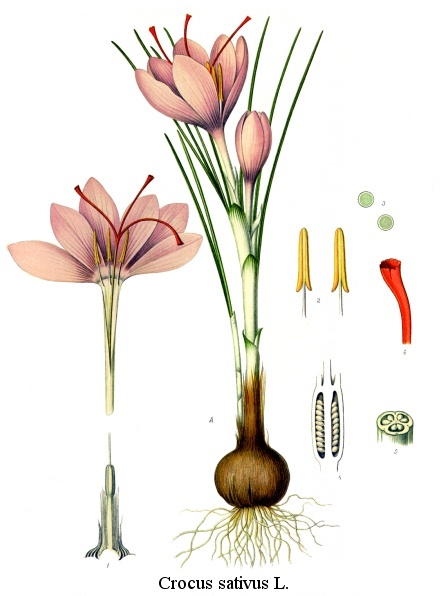|
||||
|
| Saffron is a precious and intriguing species
Crocus species are members of the family Iridaceae. The plants in this family are herbs with rhizomes, corms or bulbs. The family Iridaceae embraces about 60 genera and 1,500 species. The genus Crocus includes native species from Europe, North Africa and temperate Asia, and is especially well represented in arid countries of south-eastern Europe and Western and Central Asia . Among the 85 species belonging to the genus Crocus, C. sativus L. (Saffron) is the most fascinating and intriguing species. This is not only because it produces the well known Saffron spice, but for the numerous mysteries surrounding its origins. Questions as when it originated; the native area or areas; the ancestor species and the mechanisms of origin; the wild or naturalized plants; the infertility and consequent absence of fruit and seeds; remain to be explained. Greece (Crete) has been mentioned as probable origin of this old crop with probably more than 4,500 years of age. If its domestication occurred at more sites simultaneously or at different times is still not resolved. This is because saffron is not known to be wild or spontaneous and can only be propagated by human help. In addition to being the most precious spice in the world, saffron possesses a set of somewhat unique agronomic and eco-physiological characteristics including a relatively low water use, growth and development during fall and winter, a very low harvest index, a generative phase which is followed by the vegetative phase of growth and an economic yield which is produced prior to a significant vegetative growth. Furthermore it has three exceptional quality attributes, i.e . aroma, flavour and yellow dye, a set of characteristics bringing about its uniqueness for pharmaceutical, food and textile industries. Between 100,000 to 200,000 flowers are required to yield one kilogram of saffron spice (about 900,000 dried stigmas). Medium yield are around 10 kg of saffron/hectare, but varying very much between countries, lands and agronomic practices. Saffron's high price is due to the much direct labour required for its cultivation, harvesting and handling. This fact has made progressively uncompetitive this crop in the more developed countries, and undoubtedly such tendency will extent to the currently producing leaders. Therefore, there is need for increasing saffron production and quality to cope with an increasing demand and market differentiation. This will be achieved biologically by means of plants with more flowers per plant, flowers with a higher number of stigmas, increasing stigmas size or stigmas with an increased amount of dye and aroma. In a further step, a new approach could take place, the consideration of C. sativus as a source of phytochemicals and biopharmaceuticals. |
 |
C. sativus is an autumnal flowering geophyte with corms that are covered by a tunic, dormant during summer, sprouting in autumn, and producing 1-4 flowers in a cataphyll with linear leaves. The flower has an underground ovary, a style 9- 10 cm long, dividing at the top in three red trumpet-like stigmas (2.5 cm long) that once dried form the commercial spice saffron. Flowering spans from late autumn until December according to climatic conditions. Cytological studies have indicate that saffron is a triploid species which genome shows 3n=24, x=8 chromosomes. Its triploid condition allows vegetative multiplication, but not regular sexual reproduction. This is because meiosis and gamete development in triploids are irregular, resulting into many anomalies in sporogenesis and gametophyte development. |
|